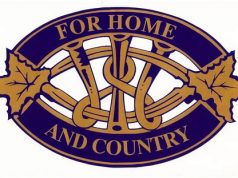Blaine Marchand, Author
“Oh kids,” my mother always teased as father slowed the car, neared Cobden along Highway 17. We knew what was coming next. “We’re home. Look Cowley Avenue.” Our refrain each time was deep groans from the back seat. None of us knew how true her words were. Only a few years ago I learned of the connection between Cobden and our neighbourhood in the city, which at that time was called Ottawa West.
The story is truly a family saga and for history buffs, an interesting one. It began in the 1831, when Mailes Cowley, 65, and his wife, Harriott, 53, left London, England, for British North America. Accompanying them on their voyage were their two children, Daniel Keyworth, age 14, and Harriet, age 8. They settled in Lower Canada where Mailes, a trained botanist, established a garden in the Montreal area. Unfortunately, he died from cholera in the following year while his wife passed away in 1833.
Their son Daniel left school to make his way in the world. He began as a grocer’s assistant and then found work as a purser on a boat that sailed the Lower St. Lawrence, from Lac St-Louis to Trois-Rivières. In 1836, he moved to Bytown to work as a book-keeper but the newly formed town was the scene of riots between French Canadians and Irish settlers, now referred to as the Shriners’ War. Daniel moved to Arnprior and signed up for Chief McNab’s militia. Years later, he found work as purser on the steamboat, the George Buchanan, which sailed from Chats Lake on the Ottawa River to Portage- du-Fort. In 1838, at the age of twenty-one, he took over as master of the vessel and began a 44-year career as an entrepreneur and pioneer of river transportation.
He became a partner with Jason Gould, who, to avoid rapids, had built an overland link consisting of 13 miles corduroy road over which passengers and freight were transported by stagecoach before returning to barges to travel on to Pembroke via Muskrat Lake and the Muskrat River. The barges were later replaced by a steamboat, the Muskrat, the first of its kind to navigate the upper Ottawa River. In turn, this was replaced by a bigger boat, named the North Star.
Captain Cowley married Mary McJanet, a Scottish immigrant who had settled in Bristol, Pontiac County, in Sand Point in 1884. They set up their home along the Ottawa River in Clarendon Township where they had 12 children, eight surviving into adulthood.
In August 1853, a bush fire, which started on Île des Allumettes opposite Pembroke, ravaged Renfrew County, devastating eight hundred square miles of territory. Captain Cowley instructed his passengers on the North Star to throw water over the ship and themselves. The boat and its passengers were brought safely to Cobden, which had been also razed by the fire. Jason Gould suffered heavy financial losses but Captain Cowley bought the North Star, operating it until 1862. He then went on to work as a superintendent of the Union Fowarding and Railway Company.
In 1867, Captain Cowley moved his family to Ottawa, buying 185 acres of land on the outskirts of the city in Nepean Township and living in a stone house, Maple Manor. That same year links to another historic moment in Cobden’s history, the finding of Champlain’s astrolabe by 14-year-old Edward Lee near Green Lake (now called Astrolabe Lake). The astrolabe was reputed to have been lost by Champlain in 1613 while he was portaging around the rapids on the Ottawa, the very same route Jason Gould used for his corduroy road. The instrument ended up on the desk of Captain Cowley, who at the time was company manager of the Union Forwarding Company, before it was sold by his boss, Richard Cassel, to a New York buyer who eventually left it in his will to the New York Historical Society. It is now in the collection of the Museum of History in Gatineau.
One of Capitan Daniel’s sons, Robert H. Cowley, became a teacher (eventually becoming the Chief Inspector for Ontario’s public and separate schools). In 1893, age 34, he bought 15 acres of his father’s farm. In 1896, he acquired an additional acreage closer to the Ottawa River for $6,000. He laid out a plan of subdivision, calling it Riverside Park as a nod to the sandy beach along the shoreline. Strategically, he decided his lots would not be sold for year-round homes but promoted the area as a summer resort for Ottawans. He speculated that holding onto the lots would make them more profitable in the years to come as Ottawa expanded. In the new subdivision, Robert honoured his father by bestowing his name on three adjacent streets – Daniel, Keyworth and Cowley.
Almost 50 years later, with my childhood home on Cowley sold and my postal address for the schoolhouse in Osceola being Cobden, it seems I have come full circle, still pretty close to home.







![Kenopic/Smith Auction [Paid Ad]](https://whitewaternews.ca/wp-content/uploads/2018/10/advertising-100x75.jpeg)

